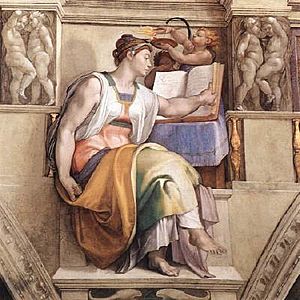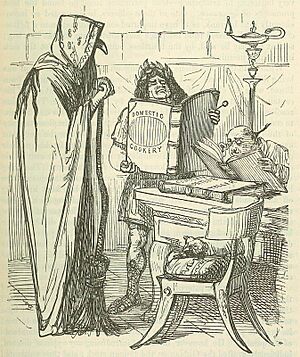Sibylline Books facts for kids
The Sibylline Books were a special collection of prophecies written in Greek as poems. They were very important to the ancient Roman Empire. The story goes that Tarquinius Superbus, a legendary king of Rome, bought them from a Sibyl, who was a kind of prophetess. These books were consulted whenever Rome faced great danger, to find out what to do.

Contents
What Were the Sibylline Books?
These books contained ancient predictions and advice. They were believed to guide the Romans during difficult times. The prophecies were written in rhyme and in the Greek language.
How Did the Books Come to Rome?
The Sibylline Books had a long journey before reaching Rome.
Their Journey from Greece
The books were first known in Greece. In the 7th century BC, they were kept in the Temple of Apollo at Gergis, near Troy in Asia Minor. People believed the Hellespontine Sibyl wrote them. Later, they moved to Erythrae, also in Asia Minor, and were then linked to the Erythraean Sibyl. From there, this collection seems to have traveled to Cumae, Italy, and finally to Rome.
King Tarquin Buys the Books
A famous story tells how King Tarquinius Superbus bought the books from the Cumaean Sibyl. She offered to sell him nine books of prophecies. But Tarquin thought the price was too high and refused. So, the Sibyl burned three of the books. She then offered the remaining six books for the *same* price. Tarquin refused again, and she burned three more! Finally, to save the last three books from being destroyed, Tarquin bought them for the original price. He then placed these three precious books in the temple of Jupiter in Rome.
Who Took Care of the Books?
The Sibylline Books were very important, so special people were chosen to look after them.
The Keepers of the Books
At first, two Roman nobles, called patricians, were in charge of the books. Later, starting in 367 BC, ten keepers were appointed. Five were from the noble families, and five were from the common citizens. Even later, around the time of Sulla (88-78 BC), the number of keepers grew to fifteen.
Their main job was to consult the books when Rome faced dangers. They would find out what actions or ceremonies were needed to overcome threats. However, they never revealed the actual prophecies. They only told the Romans what they needed to do.
How the Books Influenced Rome
The books had a big impact on Roman religion. They helped bring in new gods and beliefs from the East, like Apollo, the "Great Mother" Cybele, and Ceres. They also introduced some Greek pagan beliefs into the Roman pagan religion.
What Happened to the Books?
The original Sibylline Books faced destruction and were later replaced.
The Books Are Destroyed
Because the verses were in Greek, the keepers always had two Greek translators to help them. Sadly, the original books were destroyed when the Temple of Jupiter burned down in 83 BC.
New Books Are Gathered
After the fire, the Roman Senate sent messengers in 76 BC to find similar prophecies. They searched in places like Troy, Erythrae, Samos island, 'Africa' (which means modern Tunisia), and from Sicily and Tibur in Italy. When the new collection arrived in Rome, Roman priests carefully sorted them. They kept what they believed was true and removed the rest.
Later Years of the Books
In 12 BC, the Roman Emperor Augustus moved the books to the Temple of Apollo. There, they were studied, and a new copy was made. They stayed there until 405 AD. It is said that Stilicho, a powerful general, ordered them to be burned around that time.
Sibylline Books vs. Sibylline Oracles
Modern experts believe that the original Sibylline Books are not the same as the Sibylline Oracles. The Sibylline Oracles were often mentioned by early Christian writers from the 2nd to the 5th century AD.
For example, a Christian writer named Athenagoras of Athens quoted from these Oracles around 176 AD. He wrote A Plea for the Christians to Emperor Marcus Aurelius when Christians were being punished. Athenagoras quoted the Oracles word-for-word, along with writings by Homer and Hesiod. He often wrote that "these books are all known to Caesar" (the Emperor). Since the Sibylline Books were still in the Temple of Apollo at Rome at this time, it's possible that some parts of the Sibylline Oracles were similar to the original books.
About 70 lines believed to be from the real Sibylline Books were quoted in a 2nd-century book called Book of Marvels by Phlegon of Trales. This quote talks about the birth of a hermaphrodite and ceremonies for sacrificing to idols.
Times the Books Were Consulted
The Sibylline Books were consulted many times throughout Roman history. Here are some examples:
- 238 or 240 BC: The 'Flower Games' (Ludi Florales) were started based on the Books' advice.
- 216 BC: After Hannibal, the general from Carthage, defeated a Roman army at the battle of Cannae, the Books were consulted. On their advice, two Greeks and two Gauls were buried alive in the market of Rome.
- 204 BC: During the Punic Wars, the Roman commander Scipio Africanus brought the idol of Cybele from Pessinos to Rome. This was done on the Books' advice, and her worship began in Rome.
- 63 BC: A noble named Cornelius tried to take control in Rome because of a prophecy.
- 44 BC: A prophecy said that only a king could defeat Parthia. This caused rumors that Julius Caesar, the leader of the Roman Republic, wanted to become a king.
- 14-37 AD: During the rule of Tiberius, the Tiber river flooded Rome. One priest suggested consulting the Books, but Tiberius refused. He believed they should remain secret.
- 271 AD: The Books were consulted after the Romans were defeated by the Germanic tribe Alamanni at the battle of Placentia.
- 312 AD: When generals Maxentius and Constantine I prepared to fight at the Milvian Bridge, Maxentius consulted the Sibylline Books and lost. Constantine, who changed his faith to Christianity, won the battle.
See also
Template:KIDDLE XL START  In Spanish: Libros sibilinos para niños Template:KIDDLE XL END
In Spanish: Libros sibilinos para niños Template:KIDDLE XL END


